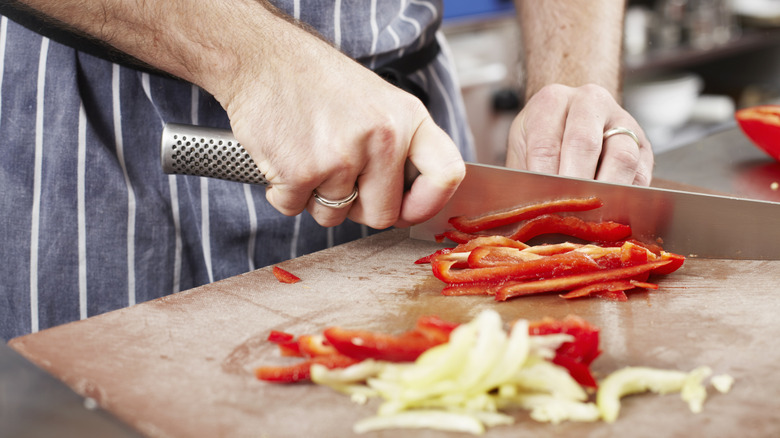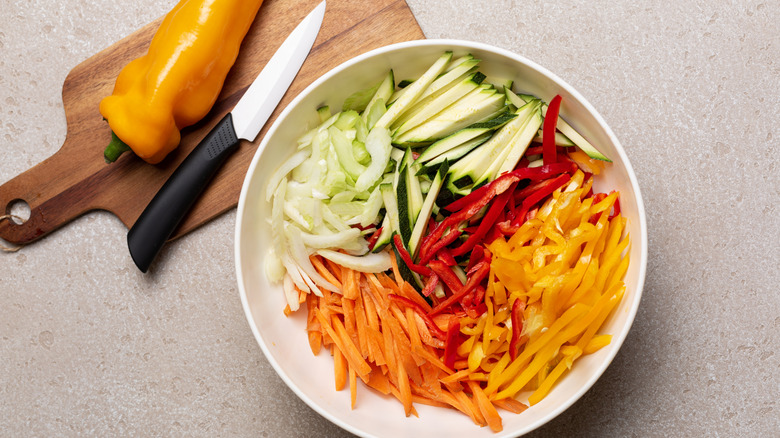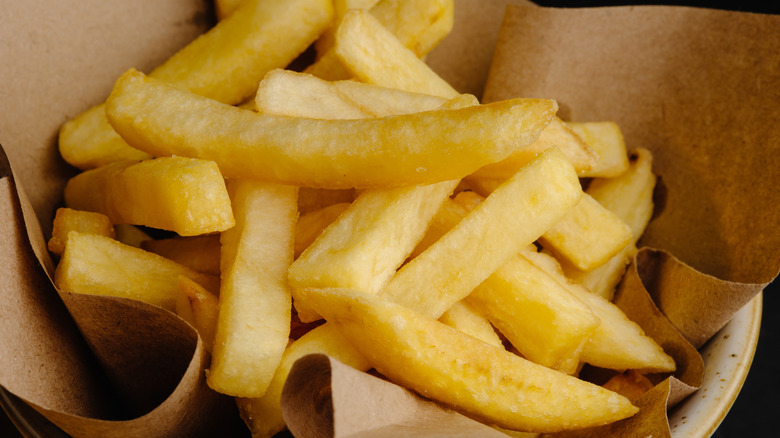Julienne Vs Baton Knife Cuts: What's The Difference?
For those who didn't go to culinary school, the details of knife-slicing can feel like a mystery. Sure, sometimes recipes call for slicing thin, while others require chopping into blocks. Yet past a quick glance at the written out suggestions, the rest falls to intuition. While such knife work experience gets the job done, if you're looking to enhance your prep work precision, you need to familiarize yourself with the cut types. When you're slicing into long strips, you'll want to start by versing in the details of the julienne and baton.
These two are nearly opposite in their aim. Baton cuts are thick, setting you up for either large, chunky bites, or nice-looking but substantial diced cubes. Meanwhile, the more well-known julienne is all about thin and slender, with around a third of the width per side. Useful as both a foundation in stir-fries or as a garnish, it's one of the most versatile strip types. So, to bring a fine-dining edge into the kitchen, practice such cutting down to the millimeter. Also, don't forget you'll need a proper kitchen knife type. Before you can cut any strips, it's necessary to shape vegetables into a rectangular form, so you'll want the right utensil for the job.
Julienne cuts produce versatile thin strands
Out of all the strip cuts, the julienne is one of the best known and widely used. Also known as the matchstick cut, it involves food cut into around 3-inch long string, with a width and thickness of around an ⅛ to a ¼ inch. The precise dimensions vary per chef, and some also delineate the thinner versions to a fine julienne. Additionally, there might be some variation based on the vegetable, with some more predisposed to thin slicing than others.
Julienned vegetables have a thin size that lends to uniform cooking. It's how you'll want to slice your carrots and peppers to achieve the ideal texture in a stir fry. And it creates the ideal vegetable consistency in slow-cooked dishes, whether it's a chicken fricassee or roasted leg of lamb.
Furthermore, such thin, aesthetic-looking strips are ideal for raw dishes. You can simply julienne some carrots into a standalone salad, or then add them to a coleslaw. Alternatively, this knife cut is the ideal way to create eye-catching zucchini strands, or a nicely sliced turnip dish. And julienned vegetables can act like an eye-catching garnish, such as the thin strands of cucumber atop ramen. Getting these strips to a tee is one of the French cooking tips that will take your food to the next level, ensuring incredible consistency.
Thick baton knife cuts are ideal for large dicing
Meanwhile, a baton is the thickest of the strip cuts. It's employed to either bring the texture of vegetables to the forefront, or more commonly, to break them down further into a thick dice. The precise size differs per the chef, but lies around a ½ to ¾ inch. As with julienne, the strip is kept to around 2 to 3 inches long. And once cubed, the result is referred to as a large dice.
One of the best known examples of a baton cut is the thick french fry — so imagine the size of such a spud to estimate the shape. And the technique is also employed for other root vegetables like celery and turnips, as well as large chunks of meat, or when simply cutting up a watermelon. Most applications will involve the diced version of the baton cut, like with the large carrot pieces in a chunky soup recipe.
However, overall, this cut style is not frequently employed in the kitchen. Cooking such large strips to internal doneness is difficult, and the resultant size is a little too thick to snack on. The cut just smaller– the similarity named batonnet — is more aptly sized like the celery and carrot sticks in a crudité. So, don't confuse the two, but know when you're looking for a chunkier cut, then baton is the answer.


